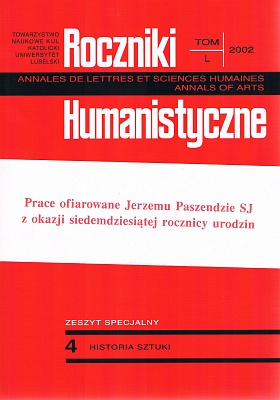The Architecture of the Post-Jesuit Church in Chojnice
Abstract
The former Jesuit church in Chojnice together with the college building forms a baroque complex, one of the most precious in East Pomerania. The history of the Chojnice Jesuits and the history of the construction of their monastery church may be reconstructed on the basis of the Jesuit chronicles: “Historia Residentiae Conecensi Societatis Jesu” of the years 1620- 1773 (ARSI). The present article presents an analysis of the style of the Chojnice church architecture, defines its artistic origin and gives a precise account of the Jesuits’ role.
Bringing Jesuits to Chojnice resulted from the denomination rivalry in the town that had unfavourable results for the Catholics. From the middle of the 16th century, when the Protestant denomination was accepted officially, in King’s Prussia Reformation tendencies became more intensive. Protestantism was also a sign of the Prussian towns-people’s separatism; however, political dependence of that province from the Crown gave a good opportunity for a counter-Reformation action.
At the beginning of the 18th century the Jesuits decided to build a new brick church; however, initially Primate Stanisław Szembek did not allow it because of the close neighbourhood of the big Gothic parish church and the cemetary. It should be thought that a change in this attitude was influenced by the denomination rivalry in the town. The construction of the church was begun in 1718, but because of shortage of money the work was stopped. Only in the years 1730-1733 construction was started again, according to a new design, and the work was finished in 1744.
The Chojnice church is a single nave, two-span building, with rows of side chapels that are connected with narrow passages. The interior of the wide nave is divided into two spans by massive wall pillars with pairs of pilasters that suppport the żaglaste vaults. The space between the pillars is formed by chapel-gallery anexes, the gallery vaults being as tall as the nave. The pillars’ quoins are cut, which visually stresses centralization of space. Illusionistic polychromies and a rich stucco decoration are a significant complementation of the interior.
In the subject literature defining the architectonic type of the Chojnice church is the basic research problem, as well as finding out about its origin and architect. According to some researchers it is a halowy building with two aisles (among others, G. Chmarzyń ski, B. Makowski, E. Dehio and E. Gall); other authors say it is a halowo-emporowy building (e.g. T. Chrzanowski and M. Kornecki) or a halowy one (A. J. Baranowski). Most researchers assume that the Jesuit builder, Jan Zelmer, was the architect of the church.
The post-Jesuit church in Chojnice is the type of wall-pillar building with galleries, and with respect to its form it is a longitudinal-central solution where within the frames of the traditional longitudinal arrangement, here limited to two spans, centralization of the interior is strongly stressed compositionally. The region closest to Chojnice where this model of church occurs is Silesia where this type of buildings was especially popular in the baroque period. The question appears if the Chojnice church was an architectonic transfer from the Silesian circle and if its design is based on a particular model. On the basis of comparative analysis we may state that the Chojnice church reveals a general resemblance to Silesian ones only in the architectonic system. From the point of view of disposition of the plan we cannot find a similar building in Silesia, whereas the pilgrimage church in Trautmannshofen (Upper Palatinate) built in 1683-1686 reveals closer analogies. A similar architectonic system is found in the circle of Czech architecture in the Visitation of the Virgin Mary church in Hejnice (1722-1729). We also do not find the motif of double windows in the span system in the circle of Silesian architecture, but such an arrangement was popular in south Germany (e.g. the Benedictine church in Weingarten, 1715-1725). In the case of the Jesuit church in Chojnice the unknown architect created another version of a nave interior with chapel-gallery annexes and with a developed wall-pillar system; the whole was composed in the system of a two-span interior. One of the building inspectors of that church on behalf of the Jesuit order was Jan Zelner who came to Chojnice from the Poznań college.
The Chojnice church, in its interior solution, is a remote architectonic import from the Czech circles and it was the Jesuits who made the decision about the import and its realization. Researchers stress the fact that the order adjusted its building foundations to the local tradition and needs as well as to the function and importance of a given centre. The area where wall-pillar churches with galleries occurred is limited mainly to the Habsburg monarchy provinces and to south Germany, that is to where there was strong rivalry between Catholics and Protestants, also in the field of architecture. In the area Jesuits propagated a defined kind of church architecture and their models from Munich, Dillingen, Prague, Olomouc and Legnica played an important role in development of baroque church architecture in Central Europe. The architectonic programme of these buildings responded to the order’s preaching needs and religious-propaganda tasks.
On the basis of our findings we may state that Jesuits brought to Chojnice an architect, may be a Jesuit, just from the circle of the Catholic provinces of Germany. The innovatory architectonic programme of the church responded to the local needs, which was connected with denomination rivalry in the town itself and the Jesuits’ counter-Reformation tasks. The church fulfilled an important identification and prestige function that was transferred to the founders and the local Catholic society.
The Jesuit church in Chojnice significantly influenced the development of the local architecture and its architectonic programme is repeated in the churches in Wysoka (the Wyrzysk district), Zamarte (a Bernardine one) and in Kcynia (a shod Carmelites’ one).
Copyright (c) 2002 Roczniki Humanistyczne

This work is licensed under a Creative Commons Attribution-NonCommercial-NoDerivatives 4.0 International License.





